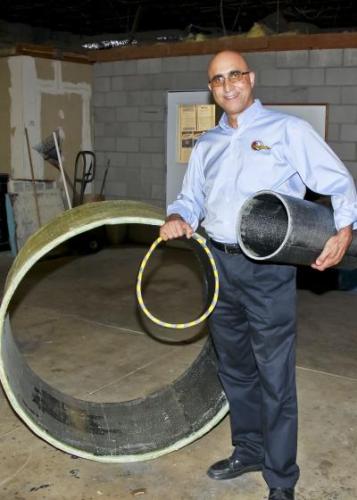Professor Emeritus of Civil Engineering at the University of Arizona and QuakeWrap president, Mo Ehsani, has developed a new underground pipe using aerospace materials to build a virtually endless length of pipeline.
 QuakeWrap president Mo Ehsani, professor emeritus of civil engineering at the University of Arizona, demonstrates carbon laminate honeycomb pipe sections of various sizes built at his facility in Tucson, Ariz.
QuakeWrap president Mo Ehsani, professor emeritus of civil engineering at the University of Arizona, demonstrates carbon laminate honeycomb pipe sections of various sizes built at his facility in Tucson, Ariz.
Ehsani utilized lightweight plastic honeycomb and resin-saturated carbon fiber fabric to build the pipe. This pipe can be built onsite and has been named as InfinitPipe as a single section of the pipe can be of virtually infinite length.
Conventional steel and concrete pipes have to be built in factories and then shipped to the desired location on large 18-wheel trucks. This may require the pipes to be transported to large distances, leading to increased transportation costs. Further, these pipes are prone to leaks and affect the environment. Joints are required every 20”, while in the InfinitPipe the expansion joints may be required only for every 1000 ft.
Touted as a green pipe, the InfinitPipe can be used for various applications including water, oil, natural gas and sewers. The production process involves wrapping layers of carbon fabric around a mandrel, putting a lightweight plastic honeycomb on it and then more layers of carbon or glass fiber over this honeycomb. This process delivers the shape of the mandrel as the pipe's internal cross-section, which may not necessarily be circular.
Ehsani found that after construction, the finished pipe could be slipped of the mandrel and the process could be continued. When a 20” mandrel is used, 18” of the pipe may be slid of the mandrel when finished, and the process can be continued to build a continuous length of pipe.
If the production equipment with the mandrel was mounted on a truck, then it may be used to create and lay pipes at the required location immediately. This technology can be used in developing countries where the local people will be able to make the pipe on the spot using a mandrel and the required raw materials.
Ehsani has refined the manufacturing process, which allows him to use better quality materials due to the smaller quantities required. So carbon fabric can be used instead of glass fabric and epoxy instead of polyester resin.